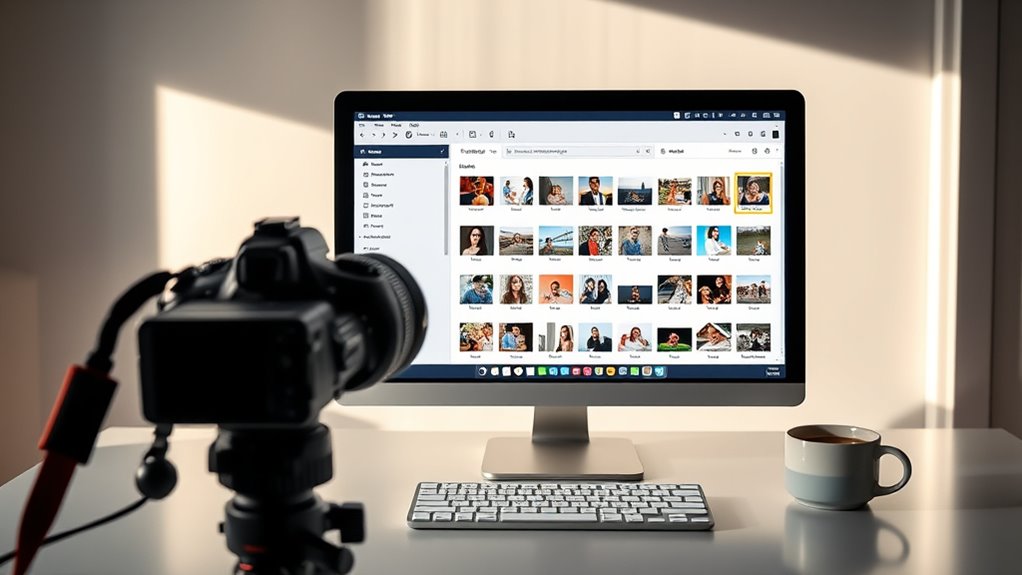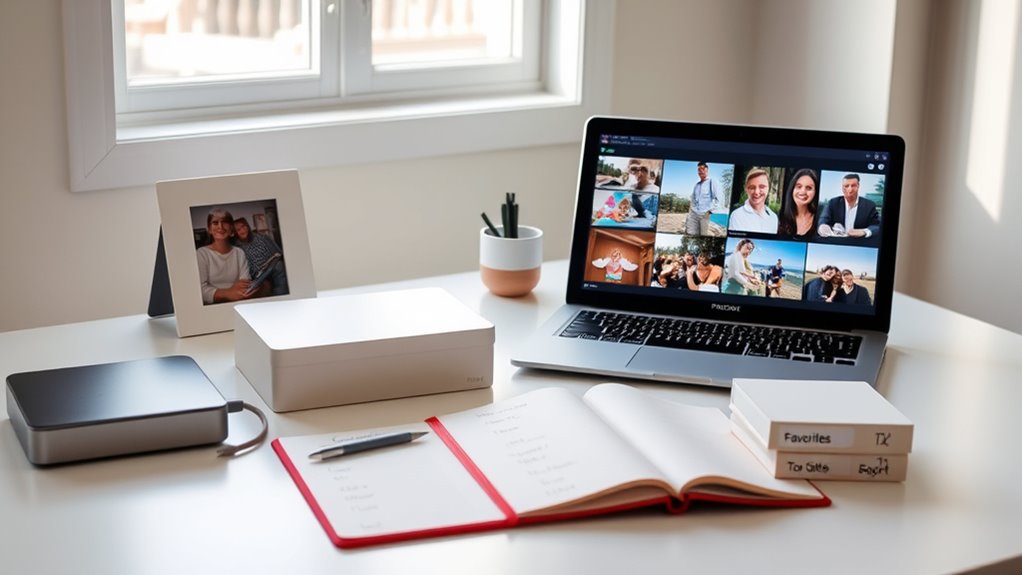To declutter your digital photos in one afternoon, start by gathering all your images into one device or external drive. Set clear goals for your collection, then create a simple folder system sorted by date or event. Delete duplicates and blurry shots to free space. Organize what’s left with tags and descriptions for easy searches. Backup your organized library and stay consistent with maintenance. Keep going, and you’ll discover even more ways to keep your collection tidy and accessible.
Key Takeaways
- Gather all photos into one device or drive and delete duplicates and blurry images to streamline your collection.
- Create a simple folder system by Year, Event, and Location for efficient organization.
- Use photo management software or AI tools to automate sorting, tagging, and categorization.
- Add clear descriptions and consistent keywords to improve searchability and recognition.
- Schedule regular backups to cloud or external storage to preserve your decluttered collection.
Gather All Your Photos in One Place

The first step to decluttering your digital photos is to gather all of them into one central location. This means transferring images from multiple devices like smartphones, cameras, and tablets to a single computer or external drive. Once everything is in one place, you can easily review, edit, and organize your collection. Use photo editing tools to enhance or crop images that are worth keeping, making your collection more streamlined. Consider sharing strategies during this process—delete duplicates and blurry shots to free up space and improve your photo library. Consolidating your photos simplifies future sorting and makes it easier to find special moments later. Additionally, understanding color accuracy can help in selecting the best images to keep, ensuring your collection reflects true-to-life colors. Exploring photo management software can further automate and simplify the organization process, saving you time and effort. Recognizing digital asset management concepts can inspire ways to streamline your photo management process with software solutions. With everything in one spot, you’ll set a solid foundation for efficient decluttering and better photo management.
Set Clear Goals and Criteria for Selection

After gathering all your photos in one place, it’s time to decide what stays and what goes. Set clear goals and criteria for selection to make this process easier. Ask yourself if a photo captures a special moment, reflects your style, or has good quality. Consider if it’s worth photo editing to improve it or if it’s suitable for photo printing. Be honest about duplicates, blurry shots, or outdated images. Establish standards for clarity, emotion, and relevance. Having specific criteria helps you stay focused and avoid second-guessing. Remember, the goal is to keep meaningful, high-quality photos that truly matter, making your digital collection more manageable and enjoyable. Clear goals streamline your decluttering and set the stage for an organized, satisfying photo library. Incorporating photo selection criteria based on image quality and emotional significance can further refine your choices. Additionally, applying principles from sound design such as layering and manipulation can inspire creative ways to enhance your favorite images. When sorting, consider how image quality impacts the overall appeal and longevity of your collection, helping you prioritize photos that will stand the test of time. Recognizing the value of fathers’ influence can also motivate you to preserve those special images that reflect meaningful relationships.
Create a Simple Folder Structure

Creating a simple folder structure is key to keeping your digital photos organized and easy to navigate. When you set up clear folders, you streamline photo editing and metadata management, saving time searching for images later. Use categories like Year, Event, and Location to create a logical hierarchy. For example:
| Year | Event | Photos |
|---|---|---|
| 2023 | Vacation | Beach, Mountains |
| 2022 | Family | Birthdays, Holidays |
| 2021 | Travel | Europe, Asia |
This structure helps you quickly locate images, apply edits, and add metadata efficiently. Keep it simple and consistent, avoiding overly complex nested folders. A straightforward folder setup minimizes clutter and keeps your photo library manageable. Additionally, understanding file organization principles can further enhance your workflow. Incorporating consistent naming conventions can also improve searchability and sorting of your photos over time. Being aware of AI-driven organization tools can further automate and optimize your photo management process.
Delete Duplicates and Unwanted Shots

To keep your photo collection manageable, you should regularly delete duplicates and unwanted shots. Use photo editing tools to quickly identify similar images or blurry photos that don’t add value. This process helps you free up space and reduces clutter. Consider sorting through your images and removing duplicates with dedicated software or apps designed for this purpose. Clearing out unwanted shots also prevents your storage solutions from becoming overwhelmed, ensuring faster access and easier backups. Regularly deleting unnecessary photos streamlines your collection, making future organization simpler. Plus, it helps you focus on keeping the best memories intact. Engaging in digital decluttering by removing excess photos can also reduce digital stress and improve your overall digital well-being. Additionally, understanding file management best practices can help you maintain an organized archive over time. Implementing these techniques can also prevent digital overload and keep your device operating smoothly. Taking these steps now saves you time later and keeps your digital archive neat and efficient, ready for easy browsing whenever you want to relive those special moments.
Organize Remaining Photos by Date or Event

Organizing your remaining photos by date or event makes it easier to find and enjoy your memories. Start with photo sorting by chronological order, which helps you see the progression of your experiences. Use the date information embedded in the file properties or add date-based folder names to keep things clear. Next, consider event labeling to group photos from specific occasions like vacations, birthdays, or holidays. Creating folders for each event allows you to locate albums quickly without sifting through endless images. Consistently applying these methods reduces overwhelm and makes future browsing seamless. Keep your system simple and logical—this way, your digital photo library becomes a well-structured collection of memories, ready to be revisited anytime you want. Incorporate organized storage techniques to further streamline your collection and prevent clutter from accumulating over time. Additionally, practicing mindful organization can help you maintain a clutter-free digital space by regularly reviewing and updating your photo organization system. Employing photo management tools can also automate some of these processes, saving you time and effort. Utilizing metadata tagging can enhance searchability and make finding specific images even more efficient.
Tag and Label for Easy Searching

Creating a consistent tagging system helps you find photos quickly and reduces confusion. Use clear, descriptive labels that accurately represent each image’s content. This way, your search process becomes faster and more efficient.
Consistent Tagging Systems
Implementing a consistent tagging system makes it much easier to find specific photos later. Your photo metadata becomes more useful when you follow clear tagging conventions. Decide on a uniform approach—use consistent keywords for events, locations, or people. For example, always tag a beach trip as “Beach-2024” rather than mixing “Beach” or “Trip to Beach.” This consistency streamline searches and reduces confusion. Establish rules for abbreviations, capitalization, and categories so your tags stay uniform across all files. When you apply these standards, your digital photo collection becomes an organized database, making retrieval quick and effortless. Remember, the key is to stick with your chosen system to ensure your tags remain reliable and useful over time.
Use Clear Descriptions
Clear descriptions are essential for making your digital photos easy to find later. When you add clear, specific labels, you improve your photo organization and simplify metadata management. Use descriptive keywords that detail the subject, location, or event—think beyond basic tags. During photo editing, update descriptions to reflect any new details or highlights. This way, searching becomes effortless, saving you time when hunting for a specific picture. Well-crafted descriptions also help you recognize images at a glance without opening each one. Remember, the clearer your descriptions, the more efficient your digital photo system becomes. Consistent, detailed descriptions are the foundation for an organized, clutter-free digital photo library you can enjoy and manage with ease.
Backup and Maintain Your Organized Collection

You need to set up a regular backup schedule to protect your photos from loss. Consider using cloud storage options for easy access and safety. Organizing your images by date helps keep your collection orderly and simplifies future maintenance.
Regular Backup Schedule
Establishing a regular backup schedule is essential to guarantee your organized photo collection stays safe and accessible. Consistent backups prevent data loss and simplify ongoing management. Set a schedule—daily, weekly, or monthly—based on how often you add new photos. Use reliable backup methods that support photo editing and metadata management, ensuring your edits and tags stay intact. Keep multiple copies in different locations to mitigate risks like hardware failure. Regularly check your backups for integrity and completeness. Here’s a simple overview:
| Backup Frequency | Benefits |
|---|---|
| Daily | Keeps recent edits safe |
| Weekly | Balances effort and security |
| Monthly | Suitable for infrequent updates |
Stick to your schedule to maintain a clutter-free, protected collection.
Cloud Storage Options
Cloud storage options provide a convenient and scalable way to back up and maintain your organized photo collection. Using these platforms guarantees your images are safe from hardware failures or accidental deletions. Many services support photo compression, which reduces file sizes without sacrificing quality, saving storage space. Once uploaded, your photos can be easily accessed from any device. Sharing platforms integrated into these services allow you to quickly distribute select images to friends and family, making collaboration effortless. Some cloud options also offer automatic backups and synchronization, keeping your collection current and organized. By choosing reliable cloud storage, you simplify ongoing maintenance, prevent clutter, and ensure your photos are preserved and accessible whenever you need them.
Organize by Date
Organizing your photos by date is an effective way to keep your collection easy to navigate and maintain. Start by sorting your images using photo metadata, which automatically records the date each photo was taken. Many editing software options allow you to view and edit this metadata if needed. Once sorted, create folders labeled by year, month, or specific dates for easy access. Regularly back up these organized folders to cloud storage or an external drive to prevent data loss. Maintaining your collection becomes simpler when your files are systematically arranged by date, making future edits or searches more efficient. Staying consistent with this method ensures your digital photos remain manageable and accessible for years to come.
Frequently Asked Questions
What if I Can’t Remember the Context of Certain Photos?
If you can’t remember the context of certain photos, don’t worry. You can use photo metadata like date, location, and device info to jog your memory. Additionally, adding your own memory aids—such as notes or tags—can help clarify the story behind each picture. These tools make it easier to identify and organize your photos, turning a confusing collection into a meaningful archive you’ll enjoy revisiting.
How Often Should I Repeat the Decluttering Process?
You should repeat the decluttering process every few months to keep your digital photos organized. Regularly update your photo backup strategies and review digital photo metadata to guarantee new images are properly stored and labeled. This consistency helps you remember the context of your photos and prevents clutter from building up. Set a reminder to revisit your collection, making it easier to maintain a tidy, organized digital photo library over time.
Can I Use Software to Automate Photo Organization?
Yes, you can use software to automate photo organization. Look for tools that offer photo tagging and automatic categorization features. These programs scan your images, identify subjects, and tag them accordingly, saving you time. With automatic categorization, your photos are grouped into albums or folders based on content or date. This way, you quickly find what you’re looking for without manually sorting through thousands of pictures.
How to Handle Photos Stored on Multiple Devices?
You should start by consolidating your photos from all devices into a central location. Use cloud storage services to upload and sync your images across devices, ensuring easy access and security. Make sure to create regular photo backups to prevent data loss. This approach simplifies managing multiple devices and keeps your digital photos organized, making it easier to declutter and find what you need quickly.
What’s the Best Way to Organize Videos Along With Photos?
They say a picture is worth a thousand words, but videos tell even richer stories. To organize your photos and videos efficiently, start with folder categorization—group similar clips together. Use metadata tagging to add keywords, dates, and descriptions for quick searches later. This combo makes finding and enjoying your memories easier, turning chaos into order. Don’t wait—start now and transform your digital collection into a well-organized treasure trove!
Conclusion
By the end of your decluttering session, your digital photo collection will shine like a well-tended garden, easy to navigate and full of cherished memories. Staying consistent with your organization routine keeps this digital landscape tidy and vibrant, preventing chaos from creeping back in. Think of it as giving your memories a cozy home where they’re safe, accessible, and ready to bring joy whenever you browse through your beautifully organized collection.








